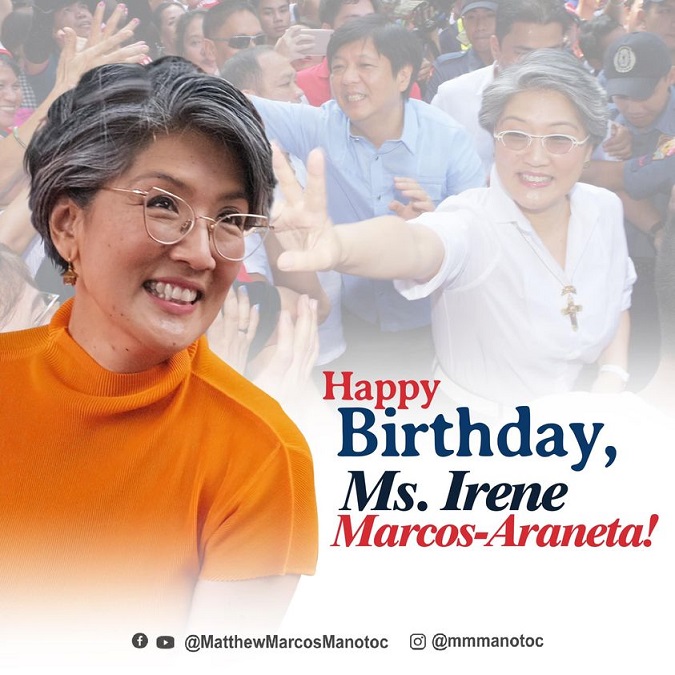This happened in 2010.
The plane trip from Manila’s NAIA2 to Laoag included her in our group. She arrived at our designated pre-departure lounge and joined us in a huddle. It was our first time to meet her. We were all museum professionals flying to Laoag to see Ilocos Norte’s Museo Iloko, the restored and adapted former Hispanic-era Tabacalera warehouse. We were also scheduled to check other heritage sites in the province and see their conditions.
She was a pleasurable personality to be with, easy to converse in small talk. She easily impressed us as intelligent, but it was her amiability that stood out. When we all boarded our plane and took up our assigned seats, she had her seat at the rearmost of the plane. She just walked down the aisle as any other nondescript passenger. She didn’t call for attention. The passengers did not seem to bother who she was.
She was Irene Marcos-Araneta. As a Marcos, she came out with a very surprisingly genuine affability. It was a pleasure to meet her. But that never erased who she was in Philippine history – she was a Marcos, that reviled name in our land because of their wily evasion from accountability, and that is that.
For many, it is the seemingly tiny matter of cozying up to the Marcoses that gives them a rose-colored lens of the family that has yet to pay us for their grand plunder of the Philippines, the extrajudicial murder of 3,257, the 35,000 documented tortures, and the 70,000 incarcerations.
Meeting a Marcos on a personal basis is no different from having a Marcos on the larger stage of Philippine politics – all it needs is presence of mind, level-headedness and unflappability of who they are and what they have done. She gamely told us that we would be visiting the 1779 Santa Monica Church of Sarrat. “That is where my wedding took place,” she added. One colleague could not hold back nonchalance and blurted: “Yes, and then there was an earthquake that toppled the church’s belfry after your wedding.”
The reference to the intensity 7 temblor on the Rossi-Forel scale on August 17, 1983 was apt. It was a mere four days preceding the dictator Marcos’s greatest faux pas – the state-organized assassination of Ninoy Aquino. He did not heed the omen. Nature and the gods had conspired as a wedding postscript to what was an imeldific display of scandalous extravagance and pomposity when the country was reeling from a severe economic crisis because it was the height of their raids on government banks and our dollar reserves for their nouveau-riche fantasies.
Irene Marcos is not a lesser and illusory Marcos because of her non-political path. In fact, she is very much the same Marcos of the plundering pedigree.
She openly participated in the Sandiganbayan’s Civil Case No. 0141 (Republic of the Philippines vs. Ferdinand E. Marcos et al). Later resolved by the Supreme Court en banc as G.R. No. 152154, it covered the matter of the Marcos money recovered from Switzerland that was turned over to the Philippine government and held in escrow by the Philippine National Bank.
She was a respondent that contested the money the high court had resolved, that: “The Swiss deposits which were transferred to and are now deposited in escrow at the Philippine National Bank in the estimated aggregate amount of US$658,175,373.60 as of January 31, 2002, plus interest, are hereby forfeited in favor of petitioner Republic of the Philippines.”
But this was not the bombshell. The world’s press had gotten wind of the fast-paced sleuthing that had taken place in Dusseldorf, Germany one February 12 day. It could have been a script for a crime suspense thriller. Security cameras had recorded the visit of Irene, her husband Greggy Araneta, and Edna Camcam to Deutsche Bank in Dusseldorf. Camcam was the mistress of Marcos henchman Fabian Ver and was suspected to have held some of the Marcos loot in Hongkong bank accounts. With them were three Americans.
Unfortunately for Irene, the Australian Reiner Jacobi was sipping coffee at the bank’s lounge that moment they entered the bank’s premises. The name Reiner Jacobi strikes terror into the hearts of the Marcoses. He was hired by the Presidential Commission on Good Government to help track down the worldwide Marcos loot.
Unknown to Irene, Jacobi was there because the three Americans she had contracted to help her facilitate the money transfer had secretly sought help from Jacobi. Irene had promised commissions to them and Camcam. In fact, they had requested for new accounts for them to deposit their commissions. A whole trap was set. Jacobi had chosen Deutsche Bank and the particular account officer Irene was to talk to. It was all pre-determined.
“Irene Marcos Araneta, daughter of the late dictator Ferdinand Marcos, recently tried to move her family’s supposed ill-gotten wealth — including at least $13.2 billion in a controversial account with the Union Bank of Switzerland account — into a newly opened account at Deutsche Bank,” reported CNN on March 22, 2001. That was fast. Irene and Greggy had planed in from Germany to Manila aboard Lufthansa flight LH750 on February 24. German Secret Service agents recorded everything.
The Philippine press had by then related the attempts made by Irene in 1998 for two cash transfers to other accounts in Lichtenstein and Luxembourg. One account she had withdrawn from in Switzerland was further broken into smaller accounts distributed among small municipal banks in the British Virgin Islands. Even after their fall from power, the Marcoses continued to transact business from their hidden bank accounts. They did not learn the hard lesson from their disgraceful ouster.
The Dusseldorf transfer was foiled. But it revealed who the Marcos family treasurer was – Maria Victoria Irene Romualdez Marcos- Araneta.
The views in this column are those of the author and do not necessarily reflect the views of VERA Files.
